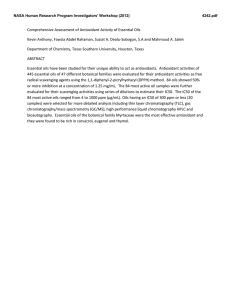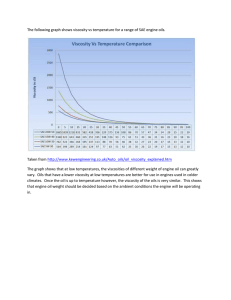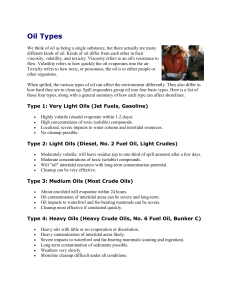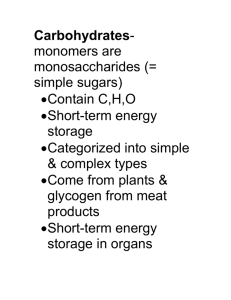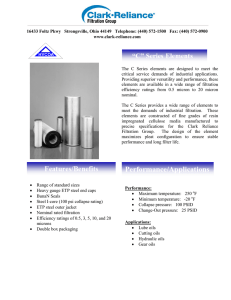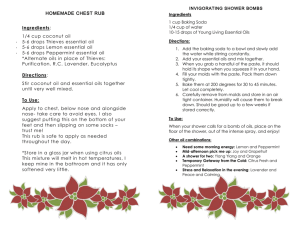Environmental Management System Procedures
advertisement
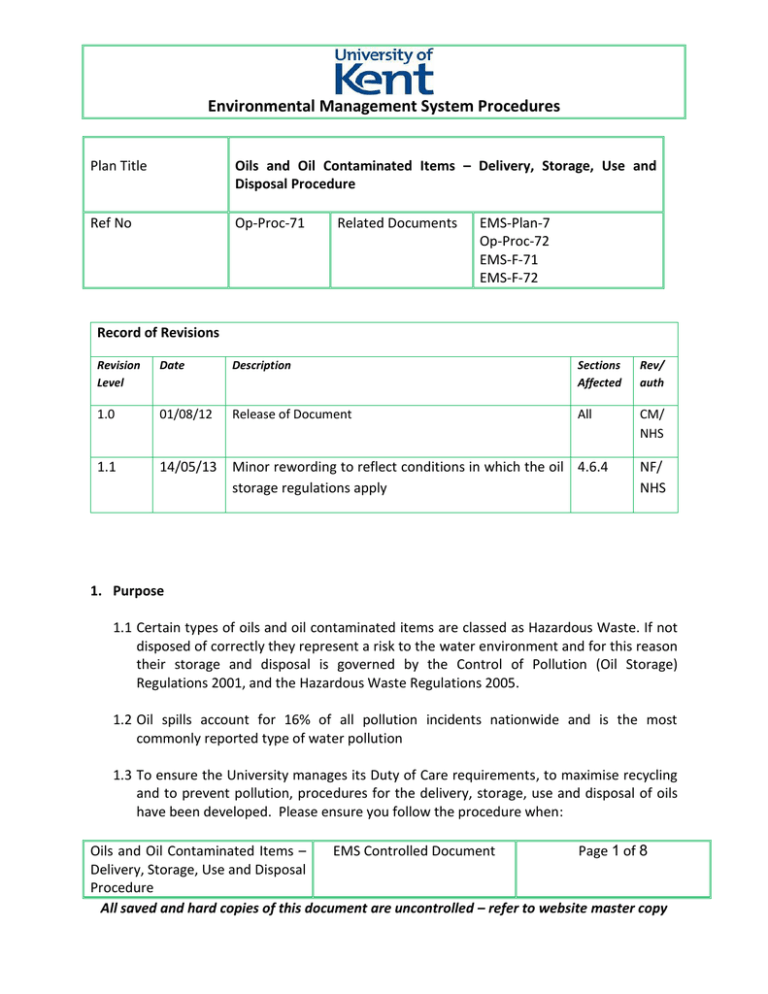
Environmental Management System Procedures Plan Title Oils and Oil Contaminated Items – Delivery, Storage, Use and Disposal Procedure Ref No Op-Proc-71 Related Documents EMS-Plan-7 Op-Proc-72 EMS-F-71 EMS-F-72 Record of Revisions Revision Level Date Description Sections Affected Rev/ auth 1.0 01/08/12 Release of Document All CM/ NHS 1.1 14/05/13 Minor rewording to reflect conditions in which the oil 4.6.4 storage regulations apply NF/ NHS 1. Purpose 1.1 Certain types of oils and oil contaminated items are classed as Hazardous Waste. If not disposed of correctly they represent a risk to the water environment and for this reason their storage and disposal is governed by the Control of Pollution (Oil Storage) Regulations 2001, and the Hazardous Waste Regulations 2005. 1.2 Oil spills account for 16% of all pollution incidents nationwide and is the most commonly reported type of water pollution 1.3 To ensure the University manages its Duty of Care requirements, to maximise recycling and to prevent pollution, procedures for the delivery, storage, use and disposal of oils have been developed. Please ensure you follow the procedure when: Oils and Oil Contaminated Items – EMS Controlled Document Page 1 of 8 Delivery, Storage, Use and Disposal Procedure All saved and hard copies of this document are uncontrolled – refer to website master copy Environmental Management System Procedures 1.3.1 Delivering or taking off (or supervising the delivery or take-off of) oils from tanks or other storage containers. 1.3.2 Storing oils either prior to use or as waste oils awaiting collection. 1.3.3 Using oils to prevent the risk of any oils entering the surface water system through spills. 1.3.4 Disposing of waste oil and oil contaminated items as their disposal is banned from landfill and discharge to surface water drains and MUST be disposed of via a specialist waste contractor. 2. Scope 2.1 These procedures cover the delivery, use, storage and disposal of all oils including fuel oil and catering oil on the Canterbury and Medway campuses. 2.2 Specifically this procedure covers the following materials and areas: 2.2.1 Grounds Maintenance – Fuel oil (diesel and petrol), engine oils, oil contaminated items. 2.2.2 Estates Maintenance – Various oils used for maintenance purposes. 2.2.3 Generators – Small quantities of diesel fuel used to power emergency generators in major buildings. 2.2.4 Catering Outlets – Cooking oil. 2.2.5 Lifts – Hydraulic oil. 2.2.6 Main Boiler House – Heavy fuel oil (currently stored but not used). 2.2.7 Workshops – Used by various academic schools for cutting and other engineering uses. Oils and Oil Contaminated Items – EMS Controlled Document Page 2 of 8 Delivery, Storage, Use and Disposal Procedure All saved and hard copies of this document are uncontrolled – refer to website master copy Environmental Management System Procedures 3. Responsibility 3.1 Heads of Schools and Department Directors have responsibility for the implementation of this Procedure. 3.2 Heads of Schools and Department Directors shall ensure that their staff members are equipped to implement this Procedure and that staff are given sufficient training relevant to their responsibilities. 3.3 Heads and Directors have responsibility for ensuring that their school or department is compliant with the appropriate legislation and other requirements in accordance with this Procedure. 4. Procedure 4.1 Delivery of Oils – Tanker deliveries 4.1.1 Detailed procedures specifically for the delivery of large quantities of diesel fuel to the Grounds Maintenance yard have been produced due to the high potential environmental impact in the event of a spill. 4.1.2 The Estates Department is responsible for ensuring that these procedures are applied and that a competent member of staff is present to oversee all deliveries of diesel oil to the Grounds Maintenance yard. Only staff trained in delivery and emergency procedures should supervise deliveries. 4.1.3 Spill kits will be kept in an accessible location for use in the event of a spill and staff supervising deliveries will be trained in their use. 4.1.4 The Estates Department should monitor the level of diesel in the tank regularly and always dip the tank prior to a delivery to ensure there is sufficient capacity for the oil delivered. 4.1.5 Upon arrival of the delivery the Estates representative should check the delivery paperwork to ensure the correct quantity and grade of oil is delivered. Oils and Oil Contaminated Items – EMS Controlled Document Page 3 of 8 Delivery, Storage, Use and Disposal Procedure All saved and hard copies of this document are uncontrolled – refer to website master copy Environmental Management System Procedures 4.1.6 Surface water drains should be protected during the delivery process by a drain cover or similar. 4.1.7 The Estates representative should ensure (or oversee) that the delivery hose is connected properly to the correct fill pipe and that all inlet valves are set to accept the delivery. 4.1.8 Throughout the transfer of oil the Estates representative should watch the vent/overflow pipe to check for leaks or overflow and inform the tanker driver immediately if there is a problem. 4.1.9 Once the fuel has been delivered all inlet valves should be shut and caps and locks replaced. The Estates representative should then agree the delivered quantity and sign the delivery note. Paperwork should be kept on site for a minimum of 5 years. 4.1.10 A poster showing this procedure (EMS-F-71) should be displayed in the Grounds Maintenance yard in the area where diesel fuel oil is delivered. 4.2 Delivery of Oils – Drums 4.2.1 Detailed procedures specifically for the delivery of large (205 litre) drums to the Grounds Maintenance yard have been produced due to the high potential environmental impact in the event of a spill. 4.2.2 The Estates Department is responsible for ensuring that these procedures are applied and that a competent member of staff is present to oversee all deliveries of oil to the Grounds Maintenance yard. Only staff trained in delivery and emergency procedures should supervise deliveries. 4.2.3 Spill kits will be kept in an accessible location for use in the event of a spill and staff supervising deliveries will be trained in their use. 4.2.4 Prior to taking delivery of oil drums the Estates Department should ensure there is available capacity to store the oil and that the bund volume is sufficient. Oils and Oil Contaminated Items – EMS Controlled Document Page 4 of 8 Delivery, Storage, Use and Disposal Procedure All saved and hard copies of this document are uncontrolled – refer to website master copy Environmental Management System Procedures 4.2.5 Upon arrival of the delivery the Estates representative should check the delivery paperwork to ensure the correct quantity and grade of oil is delivered and check the condition of the drums. 4.2.6 Surface water drains should be protected during the delivery process by a drain cover or similar. 4.2.7 The Estates representative should ensure (or oversee) that the delivery is unloaded carefully and that drums are placed within the bund. 4.2.8 Once the oil has been delivered the Estates representative should agree the delivered quantity and sign the delivery note. Paperwork should be kept on site for a minimum of 5 years. 4.3 Delivery of Oils – Small quantities (<200 litres) 4.3.1 Heads of Schools and Departments are responsible for ensuring that these procedures are applied and that a competent member of staff is present to oversee all deliveries of oil. 4.3.2 Where appropriate spill kits should be kept in an accessible location for use in the event of a spill and staff supervising deliveries will be trained in their use. 4.3.3 Prior to taking delivery of oil the school or department should ensure there is available capacity to store the oil in accordance with section 4.6 (Storage of Oils) of this document. 4.3.4 Upon arrival of the delivery the staff member supervising the delivery should check the delivery paperwork to ensure the correct quantity and grade of oil is delivered and check the condition of the containers. 4.3.5 Once the oil has been delivered the staff member should agree the delivered quantity and sign the delivery note. Paperwork should be kept on site for a minimum of 5 years. 4.4 Use of Oils Oils and Oil Contaminated Items – EMS Controlled Document Page 5 of 8 Delivery, Storage, Use and Disposal Procedure All saved and hard copies of this document are uncontrolled – refer to website master copy Environmental Management System Procedures 4.4.1 Heads of Schools and Departments are responsible for ensuring that these procedures are applied and that only competent members of staff are permitted to use oils 4.4.2 Heads of Schools and Departments should assess the potential risks associated with the use of oils and ensure that: 4.4.2.1 When oils are used outdoors surface water and foul drains are identified and protected where necessary. 4.4.2.2 When using oils staff apply due diligence to prevent the risk of drips and spills. 4.4.3 Where appropriate spill kits should be kept in an accessible location for use in the event of a spill and staff should be trained in their use. 4.5 Fuelling 4.5.1 Detailed procedures specifically for the fuelling of vehicles in the Grounds Maintenance yard have been produced due to the high potential environmental impact in the event of a spill. 4.5.2 The Estates Department is responsible for ensuring that these procedures are applied and that only staff trained in fuelling and emergency procedures should fuel vehicles. 4.5.3 Spill kits will be kept in an accessible location for use in the event of a spill and staff should be trained in their use. 4.5.4 The Estates Department should monitor the level of diesel in the tank regularly and always measure the amount of fuel used using the attached meter. Records should be kept on site for a minimum of 5 years. 4.5.5 Surface water drains should be protected during the fuelling process by a drain cover or similar. Oils and Oil Contaminated Items – EMS Controlled Document Page 6 of 8 Delivery, Storage, Use and Disposal Procedure All saved and hard copies of this document are uncontrolled – refer to website master copy Environmental Management System Procedures 4.5.6 Estates staff should ensure that the diesel tank hose is connected properly. 4.5.7 Throughout the transfer of fuel the staff member should watch the pipe to check for leaks and overflow and shut-down the transfer immediately if there is a problem. 4.5.8 Once the fuel has been transferred the pump should be switched off. 4.6 Storage of Oils 4.6.1 To prevent the risk of pollution to ground and water all oil storage containers, wherever possible, will be positioned: In a secure area preferably under cover Away from moving vehicles to prevent collision or impact At least 10m from watercourses and 50m from wells, springs and boreholes Away from surface water drainage systems 4.6.2 Small (<200 litre) quantities of oils will be stored in suitable containers which are well labelled with the lid kept on. 4.6.3 The Oil Storage Regulations 2001 apply to oil stored outdoors in containers over 200 litres. This will include the tanks and/or oil drums located at the Grounds Maintenance yard, Main Boiler House and other areas of the University on occasion. 4.6.4 All applicable oils will be stored within a secondary containment system (SCS) such as a bund or drip tray. 4.6.5 For single tanks or drums this SCS will be able to hold 110% of the maximum volume of the container. 4.6.6 Where multiple containers are stored the SCS will be able to hold whichever of the following is greater: Oils and Oil Contaminated Items – EMS Controlled Document Page 7 of 8 Delivery, Storage, Use and Disposal Procedure All saved and hard copies of this document are uncontrolled – refer to website master copy Environmental Management System Procedures 110% of the largest container’s volume 25% of the total volume of the containers 4.6.7 All pipework and fittings attached to oil storage containers will also be located within the SCS. Where a fill pipe is not within the SCS a drip tray will be used. 4.6.8 The Estates Department is responsible for regularly inspecting all tanks and drums larger than 200 litres to check for damage, corrosion, leaks and condition of bunds. Records of inspections and maintenance will be kept on site for a minimum of 5 years. 4.7 Disposal of Oils 4.7.1 All oils (except edible oils) are classed as hazardous waste and disposal is regulated by the Hazardous Waste Regulations 2005. 4.7.2 All waste oil and oil contaminated products such as oil filters must be collected by specialist waste contractors and must not be sent to landfill. Under no circumstances should waste oil be disposed of via surface water drains or foul sewers. 4.7.3 Prior to collection waste oil and oil contaminated items must be stored in accordance with the guidance in section 4.6 (Storage of Oils) of this document. 4.7.4 When being collected all waste oil must be; Transported by a registered waste carrier Accompanied by a consignment note (see guidance note EMS) 4.8 Spill Response 4.8.1 In the event of a spill the Spill Response Procedure (Op-Proc-72) should be followed. Oils and Oil Contaminated Items – EMS Controlled Document Page 8 of 8 Delivery, Storage, Use and Disposal Procedure All saved and hard copies of this document are uncontrolled – refer to website master copy
